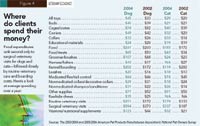Don't x-ray clients' wallets
25 percent of practitioners say they start seeing resistance when a bill lands between $200 and $400. But there's no way to know which clients will opt for your "A" plan.
A RURAL CLIENT WITH A HISTORY OF NOT PAYING FOR the best care visited Dr. Jim Kramer, co-owner of Columbus Animal Hospital in Columbus, Neb., with a farm cat in need of attention. Dr. Kramer, a Veterinary Economics Editorial Advisory Board member, assumed the client wouldn't or couldn't pay for the extensive treatment needed. But he suggested a thorough treatment plan regardless.

"To my surprise, instead of asking what the pet could get by with, she opted for the best we could provide and paid without hesitation when she came to pick up her pet." That day Dr. Kramer learned a valuable lesson: Don't sacrifice patient care by X-raying a client's wallet. You never know what he or she will choose.
Another instance drove the point home: A family brought in a pet with a tumor that would cost hundreds of dollars to treat. "I almost cried for these people as they agonized over what to do," says Dr. Kramer. "They didn't have a car, a phone, or much else. But I heard them say, 'Well, I guess we could use the freezer money to pay for his care.' And that's just what they did. They did everything they could to give this pet the best care—and we treated them with respect when no one else did."

Figure 1
As Dr. Kramer puts it, for people who have a lot, animals are sometimes just another 'thing.' But to those who have almost nothing, an animal can be everything. They want to care for their animal, and often they're willing to invest more than you expect.

Figure 2
Dr. Kramer's lesson resonates with other doctors who've learned not to sell themselves—or their practices and clients—short by prejudging. "I've learned that just because an owner will only put $10 toward her wardrobe doesn't mean she won't put a thousand dollars toward her pet," says board member Dr. W. Andrew Rollo, an associate at Gibraltar Veterinary Hospital in Gibraltar, Mich. "I've had unemployed pet owners pay the bill without question, and medical doctors who decline care for pets."
Prejudging and perceptions
The ability to pay for care, the client's connection with the pet, and the team's presentation of the estimate all play into what care clients accept. According to the 2004 Veterinary Economics Myth Versus Truth Study, most doctors think 46- to 55-year-olds are in a better financial position to pay for care. However, they say 36- to 45-year-olds are most likely to see their pets as family members. (See Figure 2.)

Figure 3
When asked at what cost they start to see clients resist care, 58 percent of your colleagues say between $200 and $600. But 8 percent of your colleagues say they don't get any resistance until they suggest care that totals more than $1,000. (See Figure 1.)
Dr. Kramer has learned to present inclusive options, always offering what's in the pet's best interest, regardless of what he thinks an owner can afford. In fact, he takes himself out of the equation by preparing a treatment plan estimate and having a team member present it. "We fail to present the best options because we lack confidence and don't want to look greedy, out of touch, or like we're trying to extort or manipulate people. The reality is we all want to help the pet."

Figure 4
Dr. Rollo sums it up, "Sometimes a technician asks me what the odds are that an owner will accept the care we recommend, and my initial assessment's often wrong. That's why we're educators, not bankers."